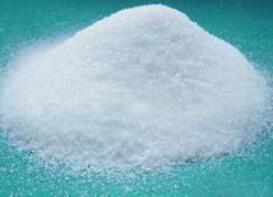The application of Neopentyl glycol
Chemical Structure
The chemical formula for Neopentyl glycol (NPG) is C5H12O2, and it is a propane-1,3-diol carrying two methyl groups at position 2. The crystalline substance (figure 1) is synthesized industrially by the aldol reaction of formaldehyde and isobutyraldehyde, which creates the intermediate hydroxypivaldehyde, which can be converted to Neopentyl glycol with either excess formaldehyde or catalytic hydrogenation of the aldehyde group to an alcohol group [1]. Neopentyl glycol is soluble in water, benzene, chloroform, and very soluble in ethanol and diethyl ether. Neopentylglycol (NPG) is a unique polyalcohol offering superior performance advantages in many end-use applications due to its high chemical and thermal stability. It is a unique diol offering superior performance advantages in many end-use applications. These advantages are derived from its chemical structure. The location of the hydroxyl groups on primary carbon atoms allows rapid esterification. Additionally, the two methyl groups, instead of the usual two hydrogen atoms, on the alpha carbon atom are responsible for the high chemical and thermal stability of Neopentylglycol and its derivatives.

Figure 1 The appearance of Neopentyl glycol
Industrial Uses
It is used in the synthesis of polyesters, paints, lubricants, and plasticizers. When used in the manufacture of polyesters, it enhances the stability of the product towards heat, light, and water. By esterification reaction with fatty or carboxylic acids, synthetic lubricating esters with reduced potential for oxidation or hydrolysis, compared to natural esters, can be produced [2]. NPG is used primarily in base resins for coatings. In powder coating formulations, Neopentylglycol offers the additional advantage of providing small differences between the glass transition temperature and melting point. Important areas of application include general metal, appliance, metal furniture, automotive and machinery coatings.
Important uses are also found in hydraulic fluids, synthetic lubricant oils, greases, metalworking fluids and aircraft engine lubricants. Other outlets include textiles, pharmaceuticals, pesticides, plasticizers and petroleum. High quality NPG is shipped as flake, molten and slurry [3]. The high-quality NPG is the component in polyester resins for industrial coatings and fiberglass-reinforced plastics applications, and most polyester resin formulations contain NPG as the sole glycol component, or it is used in conjunction with a modifying glycol to achieve desired properties. NPG is also used in polyester polyols for polyurethane coatings for the automotive, industrial maintenance, transportation, and aerospace markets.
In the United States, neopentyl glycol may be lawfully used as a reactant for coatings and other products intended for use in contact with foods under specific federal food additive regulations. [4].
Moreover, NPG has been reported that plastic crystals of neopentyl glycol exhibit a colossal barocaloric effect (CBCEs), which is a cooling effect caused by pressure-induced phase transitions. The obtained entropy changes are about 389 joules per kilogram per Kelvin near room temperature. This CBCE phenomenon is likely to be very useful in future solid-state refrigeration technologies.
References
[1] https://thechemco.com/chemical/neopentyl-glycol/
[2] https://en.wikipedia.org/wiki/Neopentyl_glycol
[3] https://www.icis.com/explore/resources/news/2006/10/03/2016417/chemical-profile-neopentyl-glycol/
[4] https://www.eastman.com/Pages/ProductHome.aspx?Product=71000146
You may like
Related articles And Qustion
Lastest Price from neopentyl glycol manufacturers

US $10.00/kg2025-04-21
- CAS:
- 126-30-7
- Min. Order:
- 1kg
- Purity:
- 99%
- Supply Ability:
- 100 mt

US $0.00-0.00/kg2025-04-21
- CAS:
- 126-30-7
- Min. Order:
- 1kg
- Purity:
- 99%
- Supply Ability:
- 20MT





